The Lamar Valley is a highlight of any trip to Yellowstone National Park. Often nicknamed “America’s Serengeti”, it is one of the best places in the world to see herds of wild bison and packs of wild wolves.
The most common way to visit Lamar Valley is to drive through it. This guide will answer all of your questions and give you details on exactly what to see, when to go, how to get there, and where you have the best chances of seeing wildlife.
If you’re planning to visit Yellowstone National Park by yourself, make your planning easy and stress free with a detailed itinerary. I have 1-, 2-, 3- and 4-day itineraries for Yellowstone National Park that include all the park highlights, give you choices based on your preferred activity level, and take all the stress out of planning your trip.
Watch everything you need to know about the Yellowstone Lamar Valley drive on video:
🔔 You can also watch this video on YouTube directly (opens in new tab).
🎙️ Or listen as a podcast:
🛏️TOP HOTEL PICK: Check availability now
🚘FIND THE CHEAPEST CAR RENTAL: Search Discover Cars for the best deals
✈️FIND THE CHEAPEST FLIGHTS: Search Skyscanner for the best deals
🧳GET TRAVEL INSURANCE: Get insured with Travelex before you go
📱TAKE AN AUDIO TOUR: Buy an audio tour now
Subscribe to daily national parks planning tips, travel inspiration and trip ideas and get instant access to the free PDF of this
Yellowstone Lamar Valley Drive
Table of Contents
The Lamar Valley, Yellowstone Park Basics
Where is Lamar Valley in Yellowstone National Park?
Lamar Valley is in the northern part of Yellowstone National Park, between Tower Junction and the Northeast Entrance, near Cooke City – Silver Gate.
How to get to Lamar Valley, Yellowstone
To get from Gardiner to Lamar Valley, drive through the North Entrance and turn towards Roosevelt/ Tower Junction. From Mammoth Hot Springs to Lamar Valley, it is a 30-minute/ 18.5-mile drive.
If you’re coming from the northeast, drive over the Beartooth Highway and through Cooke City to the Northeast Entrance.
If you’re coming from the south, drive the Grand Loop Drive in Yellowstone to Tower Junction and then turn off into the valley.
➡️ READ MORE: How To get To Yellowstone National Park
What’s the best way to see Lamar Valley?
You basically have two options. Driving Lamar Valley yourself gives you much more flexibility, and means you can stop as long as you want while waiting to see wolves – or enjoying gazing at a herd of bison for as long as you want.
However, if you prefer not to drive, or if you want the benefit of an experienced guide who will know the most likely places to see wildlife, then you can take a tour.
Lamar Valley Tours
Lamar Valley Guided Hiking Trip
A 6-hour hike in a small group with a guide to take you to the places with the best chances of seeing wildlife. Includes lunch.
➡️ BOOK THE 6-HOUR LAMAR VALLEY GUIDED HIKE.
Self-Guided Driving Audio Tour
Get the most out of your self-guided driving with an audio tour that explains all about what you are seeing along the way. Includes all of Yellowstone, not just Lamar Valley. Accessed via an app with a password.
➡️ GET YOUR SELF-GUIDED AUDO TOUR OF YELLOWSTONE.
Nature Tour of Yellowstone
Tour Hayden Valley and Lamar Valley in a small group. 12 hours. From Cody.
➡️ BOOK A SMALL GROUP ALL DAY NATURE TOUR OF YELLOWSTONE.
Private Wildlife Tour
If you prefer not to drive yourself and want a guide to take you to all the best places to see wildlife without being part of a group, then it is worth the splurge on this private full-day Lamar Valley tour.
➡️ BOOK A PRIVATE ALL-DAY WILDLIFE TOUR.
Winter Wildlife Safari
If you’re traveling in winter, then this 8-hour Lamar Valley wildlife tour is a great way to see the animals without the hassle of winter driving.
➡️ BOOK A WINTER WILDLIFE SAFARI IN YELLOWSTONE.
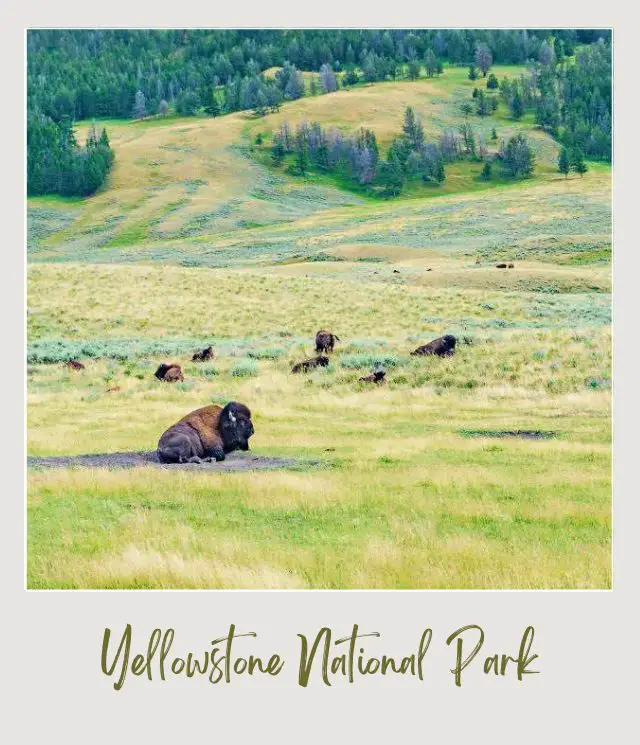
How much does it cost to visit the Lamar Valley, Yellowstone National Park?
There is no special fee to enter the valley, but there is an entrance fee to enter Yellowstone National Park. Check the NPS website for the current fee.
If you are going to be visiting several national parks in a year (or the same park more than twice), then I recommend getting the America the Beautiful Pass.
It gives you unlimited access for a year from the date of purchase to over 2,000 federal recreation sites including all U.S. national parks plus national forests and BLM lands. It includes admission for one vehicle or four people (for places that charge per person).
➡️ Buy the America the Beautiful Pass here
What’s the best time to go to Lamar Valley?
Dawn and dusk are the best time to visit Lamar Valley. “Best time” here means the best chance of seeing wildlife.
Very early in the morning and late it in the afternoon is when animals are generally most active, so this is when you have the best chance of seeing them. The light is also lovely for photography at these times of day. If you can get up early in the morning, there will also be a lot fewer people to share the roads and trails with.
Is Lamar Valley open all year?
Yes. Most of the roads in Yellowstone are closed to regular vehicular traffic in winter, and are only open for over-snow travel.
However, the North Entrance from Gardiner to Mammoth Hot Springs and the road through the entire Lamar Valley to the Northeast Entrance is cleared of snow and open all year to regular vehicular traffic.
➡️ READ MORE: Guide to Winter in Yellowstone for more details of winter travel if you’re planning a trip then.
Things to Do in Lamar Valley, Yellowstone
In Lamar Valley, ‘things to do’ all center around the wildlife since there is minimal geothermal activity in this section of Yellowstone. The most popular activity is the scenic drive.
However, there are also several hikes that give you an opportunity to get out into the beautiful landscape and possibly have closer encounters with animals (though be sure to always maintain a safe distance and respect the fact that these are wild animals!)
➡️ READ MORE: Hikes in Yellowstone National Park
What animals can you see in Lamar Valley?
The valley contains every large wild mammal (predator and prey), that inhabited it when Europeans first arrived in North America.
Animals in Lamar Valley include wolves, bison, grizzly bears, black bears, elk, pronghorns, deer, coyotes, foxes, badgers, bighorn sheep, moose, and more. Overhead, keep your eyes out for bald eagles and osprey among others.
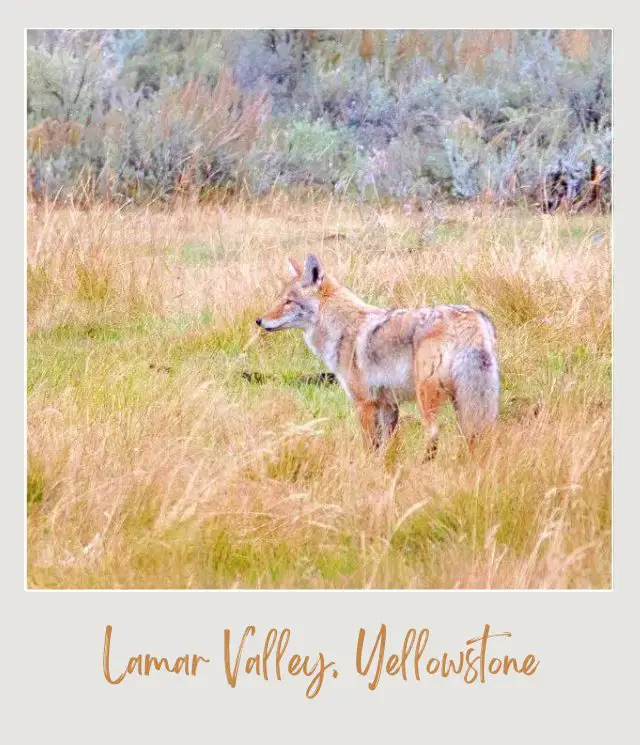
Tips For Lamar Valley Wildlife Viewing
1. Get there early and be prepared to wait. Although you can see animals throughout the day, they are most active at dawn and dusk, so this is when you have the best chance of seeing them. Many people pick a spot, set up chairs near their vehicle and wait patiently
2. Have a good spotting scope or pair of binoculars and a good camera if you want to take high quality photos. My top pick for a spotting scope is the Swarovski Optik HD-STS-80 HD Spotting Scope with 20×60 Eyepiece – get it here.
3. Be safe and follow national park guidelines. Stay at least 100 yards (91 m) from bears and wolves and at least 25 yards (23 m) from all other animals at all times.
4. If you see a cluster of vehicles parked at a pullout on the side of the road, there is a good chance they are watching wildlife. Drive slowly and park in official pullouts only. It’s very dangerous to park on the side of the road, so drive until the next pullout and park there, or turn around and go back to where everyone else was if there is a parking spot.
What do you need to bring to Lamar Valley?
Spotting scope
While there are plenty of animals in Lamar Valley, they may not walk right up to you (and you don’t want them to, anyway!). I’ve seen wolves there, but to see them properly, I needed to look through a spotting scope. A spotting scope is like binoculars, but with a single lens (kind of like a telescope). The quality of images is generally much better than with binoculars. They are typically more expensive, though.
➡️ For more information on spotting scopes, including what to look for and my top picks, read my Buying Guide to Spotting Scopes for Wildlife Viewing.
My top pick is the Swarovski Optik HD-STS-80 HD Spotting Scope with 20×60 Eyepiece – get it here.
Binoculars
If you don’t want to go to the expense of getting a spotting scope, then you will definitely want a decent pair of binoculars.
➡️ I’ve written a whole Guide to The Best Binoculars for The Money, which has more info on what to look for, plus my top picks.
➡️ My overall top choice for the best binoculars for the money are the Vortex Optics Diamondback 10×42 Roof Prism Binoculars. Buy the Vortex Optics Room Prism Binoculars here.
Yellowstone Wildlife Pocket Guide
With so much wildlife, I find that having a guide to help me identify what I see is super helpful. Leave the bulky books at home and take this Wildlife Pocket Guide with you.
➡️ READ MORE: Best Books About Yellowstone National Park
Camera
You will want to have a good camera with you. If you’re serious about photography, then you’ll need a good zoom lens and a tripod. For more active shots, I love the GoPro Hero 12. If you have a good spotting scope, you can actually use the GoPro in conjunction with the spotting scope, which acts like a zoom lens. You’ll want a tripod for the spotting scope, but it works surprisingly well.
Snacks
OK, so this isn’t directly related to watching wildlife, but the last thing you want to have to do is leave to get a snack or meal if you have amazing views of wolves, bison or bears! I always have extra snacks in the car just in case I decide to stay longer than originally planned.
It’s also not uncommon to get stuck in a ‘traffic’ jam caused by a herd of bison walking slowly down the center of the road – causing all traffic to stop and wait until it’s safe to pass.
Lamar Valley Camping
There are several options for camping Lamar Valley. Yellowstone National Park Service operates two campgrounds in Lamar Valley itself:
⛺ Pebble Creek Campground. A small campground with 27 spots for tents and RVs. Open from mid-June – late-September.
⛺ Slough Creek Campground. There are only 16 spots in this small campground, suitable for tents or small RVs. Open from Mid-June – Mid-October.
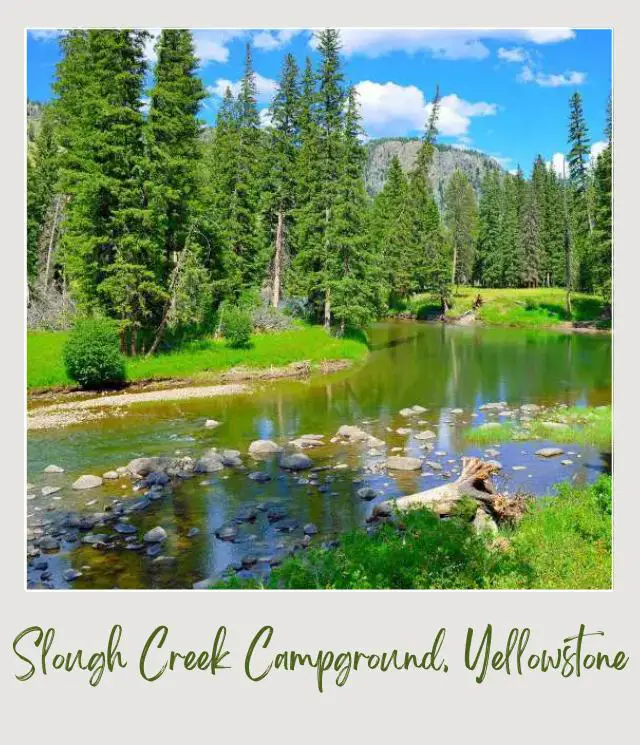
Near Lamar Valley, there are two more campgrounds inside the national park:
⛺ Tower Fall Campground. There are 31 sites for tents and small RVs on a first-come, first-served basis. Open from Mid-May – Late-September.
⛺ Mammoth Campground. 85 sites for tents and RVs, including some sites for larger rigs. This is the only campground in Yellowstone National Park that’s open year-round.
➡️ READ MORE: Guide to Camping in Yellowstone National Park has more details.
Lamar Valley Lodging
Since the best time to see wildlife is very early in the morning, it makes sense to find lodging near Lamar Valley, so you are probably trying to decide where to stay near Lamar Valley.
Although there are no lodges in the valley itself, there are several places to stay near Lamar Valley, Yellowstone.
Inside Yellowstone National Park, there are two hotels near Lamar Valley, both near the Tower Junction end of Lamar Valley.
🛏️ Mammoth Hot Springs Hotel & Cabins The hotel was built in 1936, but has been recently renovated. There are several types of hotel rooms and cabins. Unlike most of the accommodations in Yellowstone, the hotel is open in winter.
🛏️ Roosevelt Lodge and Cabins The second of the Lamar Valley hotels is a single-story log lodge building with a long porch with rocking chairs. Accommodations are basic cabins. Open in the main summer season only.
For lodging near Lamar Valley, your best bets are:
🛏️ Cooke City – Silver Gate, just outside the Northeast Entrance (➡️ check hotels and Lamar Valley cabins in Cooke City)
🛏️ Gardiner, just outside the North Entrance to the national park (➡️ check hotels in Gardiner)
Lamar Valley in Winter
Although the road is open year-round, Lamar Valley winter travel does involve some extra planning and caution.
The road may be temporarily closed after heavy snowfall until the NPS can clear the road. Check the NPS website for current conditions.
Keep in mind, too, that there is no through road beyond Cooke City, as the only road east, the Beartooth Highway, is closed in winter. So, you will have to access Lamar Valley from the North Entrance/ Gardiner and then return the same way.
Accommodations are available in the park at Mammoth Hot Springs (the campground, hotel and cabins are all open), as well as in Gardiner.
Not all animals are around and active in winter. Bears hibernate, of course. But you may get that classic photo of bison covered in snow!
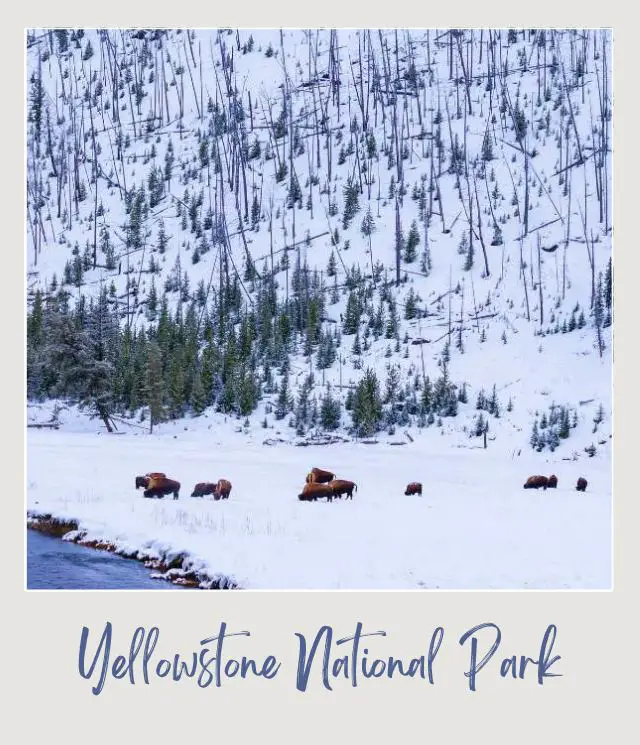
Lamar Valley Scenic Drive Description
Heading east from Tower Junction, the road dips down to the bridge over the Yellowstone River after 0.8 miles. After another 0.5 miles, you’ll come to the Yellowstone River Picnic Area. In addition to the picnic tables and restrooms, this is also the trailhead for the Yellowstone River Overlook trail (➡️ see Best Hikes in Yellowstone for more details).
For the remainder of the drive, there are numerous small pullouts on both sides of the road. Points to note along the way include:
5.4 miles from Tower Junction: Cross the Lamar River
5.9 miles from Tower Junction: The road to the Slough Creek Campground is on your left. This road is a popular place to watch for wolves.
10.6 miles from Tower Junction: On your left are the Lamar Valley Ranger Station and the Yellowstone Forever Institute – Lamar Valley Buffalo Ranch. Lamar Buffalo Ranch was originally created in 1907 to help preserve Yellowstone’s bison. It’s now the field campus for educational programs offered by the NPS and the Yellowstone Forever Institute.
14.3 miles from Tower Junction: Lamar Valley Lookout. Vault toilets. This is a popular place to see bison in the valley below.
14.3 miles from Tower Junction: Lamar River Trailhead. This trail is 33 miles long, but there are popular shorter versions. It’s 4 miles roundtrip to the Lamar River and 7 miles round trip to Cache Creek. Both give you good chances of seeing wildlife, but have no shade. Get here early to secure a parking spot and to maximize your chances of seeing wildlife.
➡️ Read my Guide To The Best Hikes in Yellowstone for more details.
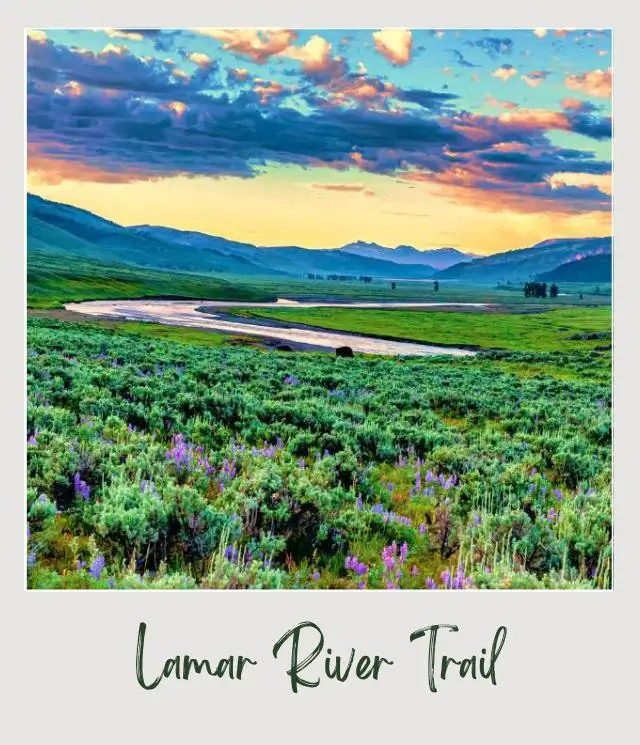
15.7 miles from Tower Junction: Soda Butte. It’s hard to miss this small butte. It sticks up on the side of the road (on the right driving from Tower Junction). There is very little geothermal activity in Lamar Valley, but this hot spring is an exception. I have often seen small herds of bison here.
17.8 miles from Tower Junction: Trout Lake Trailhead. You can take an easy 1.2-mile loop trail to a lake where, as the name suggests, there is good trout fishing (permit required). In summer, there are beautiful wildflowers, and the mountain backdrop is stunning.
19.0 miles from Tower Junction: Pebble Creek Campground
21.1 miles from Tower Junction: Soda Butte Creek picnic area. This is a great place for a picnic lunch. After this, the drive starts to get much more woodsy without the expansive valley views.
21.8 miles from Tower Junction: Small bridge crossing Soda Butte Creek
25.4 miles from Tower Junction: Small bridge crossing Soda Butte Creek
27.1 miles from Tower Junction: Warm Creek Picnic Area. Another nice option for a picnic lunch, snack or rest stop.
28.1 miles from Tower Junction: Meridan Road
28.2 miles from Tower Junction: Northeast Entrance Station
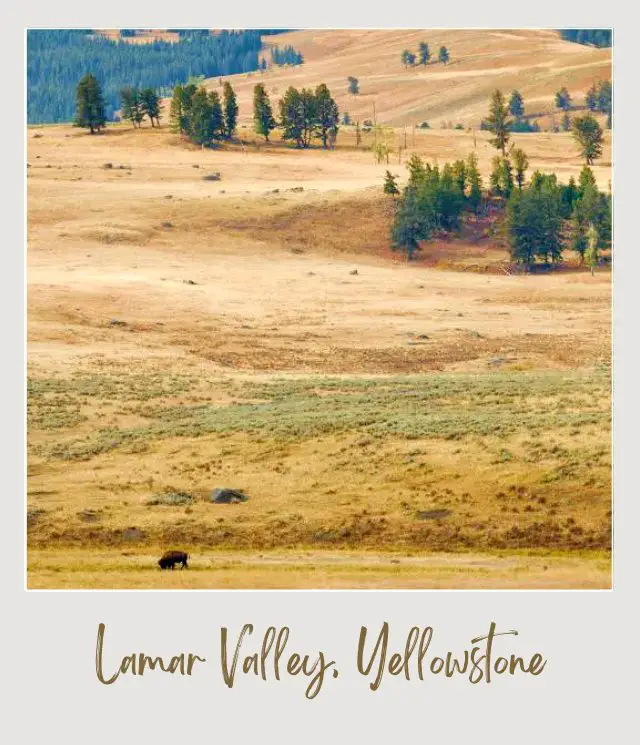
Lamar Valley, Wyoming FAQs
How long does it take to drive Lamar Valley?
To drive the entire 33 miles from Tower Junction to Cooke City takes about an hour each way. However, you should allow longer than that, so you can stop and enjoy the wildlife along the way.
➡️ READ MORE: Grab one of my detailed (1-4 day) itineraries for Yellowstone National Park, which include time in Lamar Valley.
Can I drive through Lamar Valley?
Yes, you can drive Lamar Valley all year round. However, in winter, there is no access from the east; only from the North Entrance/ Gardiner.
What time should I get to Lamar Valley?
You should get to Lamar Valley at dawn or at dusk. This is when animals are most active
What road is Lamar Valley on?
The Northeast Entrance Road (Route 212) runs the length of the valley.
How can I see animals in Lamar Valley?
The best way to see animals in Lamar Valley is to use a spotting scope or binoculars. Spotting scopes will give you better quality images and often have greater zoom capacity, so these are better if you’re serious about wildlife viewing. If you’re more of a casual wildlife watcher, a good pair of binoculars will do.
➡️ READ MORE: Buying Guide to Spotting Scopes for Wildlife Viewing. My top pick is the Swarovski Optik HD-STS-80 HD Spotting Scope with 20×60 Eyepiece – get it here.
➡️ Guide to The Best Binoculars for The Money. My overall top pick for best binoculars for the money are the Vortex Optics Diamondback 10×42 Roof Prism Binoculars. Buy the Vortex Optics Room Prism Binoculars here.
How do you see wolves in Lamar Valley?
Lamar Valley is wide and open, so seeing wolves is easier here than in most places. The main Lamar Valley wolf pack, the Junction Butte Pack, can often be seen from pullouts on the side of the main road. The road to Slough Creek is another popular spot to see wolves.
Lamar Valley is widely considered the best place to see wolves in Yellowstone, but a good spotting scope or pair of binoculars is recommended.
What time are the wolves in Lamar Valley?
The Lamar Valley wolves are most active at dawn and at dusk. For morning viewing, get there before sunrise, so you have the best chances of seeing them. Keep in mind that wolves are wild animals and do roam quite large distances in search food, so there is never a guarantee you will see them.
Are there moose in Lamar Valley?
It is possible to see moose in the meadows and down by the rivers in Lamar Valley. However, they are more commonly seen in Grand Teton National Park, which is just south of Yellowstone.
➡️ READ MORE: Guide to Grand Teton National Park
Can you drive to Lamar Valley in winter?
Yes, you can drive to Lamar Valley via Gardiner and the North Entrance all year. You can drive though Lamar Valley to the Northeast Entrance, but in winter there is no access east beyond Cooke City, which lies just outside the Northeast Entrance.
Where is the Lamar Valley in Yellowstone?
Lamar Valley is in the northeast corner of Yellowstone National Park. It lies between Tower Junction to the west and the Northeast Entrance to the east.
How far is Lamar Valley from West Entrance?
It takes 1 hour 45 minutes to drive from Yellowstone’s West Entrance to Tower Junction, the start of Lamar Valley (without any traffic). This is 66 miles.
What entrance is near Lamar Valley, WY?
The Northeast Entrance is the nearest Yellowstone National Park entrance to Lamar Valley. In fact, Lamar Valley starts at the Northeast Entrance and extends westwards towards the North Entrance.
What part of Yellowstone is Lamar Valley?
Lamar Valley lies in the northeast section of Yellowstone National Park, between Tower Junction and he Northeast Entrance to the park. It is not part of the figure-8 Grand Loop Road, but extends eastwards off the top right (northeast) part of the figure 8, at Tower Junction.
Is Lamar Valley Worth It?
Yes. Lamar Valley is one of the highlights of any trip to Yellowstone National Park. Yellowstone has been nicknamed “America’s Serengeti” due the number and diversity of wildlife in Lamar Valley and Hayden Valley. This is one of the best places in the entire country to see bison in the wild, and one of the best places in the world to see wolves.
Lamar Valley vs Hayden Valley
These two valleys are the two main areas in Yellowstone National Park to see wildlife. Hayden Valley is smaller but closer to other attractions like the Grand Canyon of the Yellowstone.
Both are excellent places to see wildlife. If at all possible, schedule enough time in your itinerary to see both.
Yellowstone Map: Lamar Valley
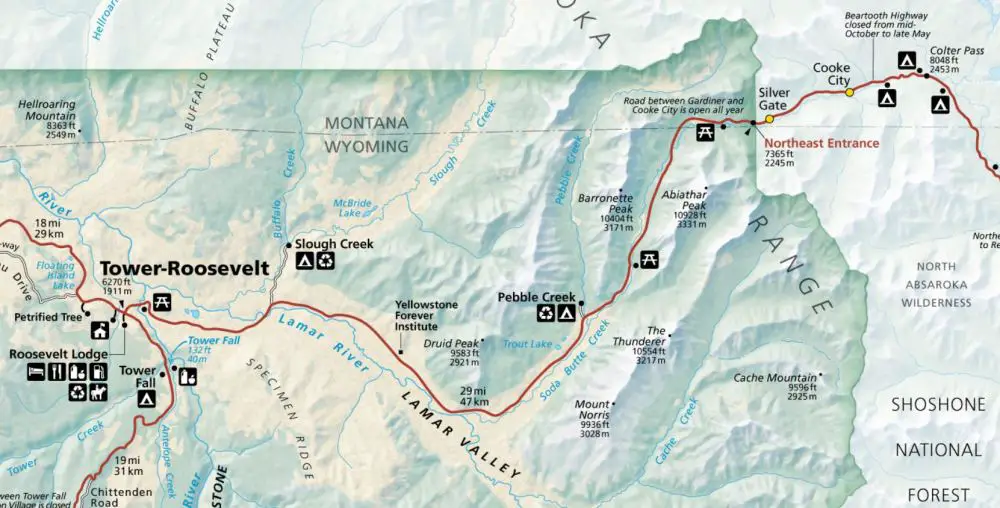
Travel Insurance for Yellowstone National Park
You should definitely have travel insurance when you travel to Yellowstone. Good travel insurance will cover you for trip cancellation, theft or damage if your property when traveling, medical help if you have an accident while visiting Lamar Valley or medical repatriation if you need to get medi-vaced out.
➡️ A great insurance option is Travelex. It has coverage for all you’ll need. You can compare Travel Insurance plans here or get a quote right now:
Enjoy the Lamar Valley, Montana!
More Planning Resources for Yellowstone National Park
⭐ Yellowstone National Park Guide
⭐ Yellowstone Itineraries
⭐ 7 Mistakes to Avoid
⭐ How Many Days in Yellowstone National Park?
⭐ Guide To Camping In Yellowstone National Park
⭐ How to Visit Yellowstone in Winter
⭐ Best Things To Do In Yellowstone National Park
⭐ The Best Yellowstone Scenic Drives
⭐ Tips For Visiting Yellowstone National Park
⭐ Best Waterfalls in Yellowstone National Park
⭐ Best Hikes in Yellowstone National Park
⭐ Grand Prismatic Spring Overlook Trail Guide
⭐ Best Time to Visit Yellowstone National Park
⭐ Visiting Yellowstone Throughout the Year
⭐ How To Get To Yellowstone National Park
⭐ All The Airports Near Yellowstone National Park
⭐ The Closest Airport to Yellowstone National Park
⭐ 10 Fun Facts about Yellowstone National Park
⭐ Best Books about Yellowstone National Park
⭐ Vacation Rentals Near Yellowstone National Park
⭐ Yellowstone Packing List
Do you have any other Lamar Valley tips or questions? I’d love to hear about them. Join my private Facebook group National Parks Collectors and comment and let me know (you can also pick up extra planning tips, share your photos and stories with other national park lovers and more).
Subscribe to daily national parks planning tips, travel inspiration and trip ideas and get instant access to the free PDF of this
Yellowstone Lamar Valley Drive
If you liked this article about the Lamar River Valley, Pin It to your Yellowstone National Park or Lamar Yellowstone board!

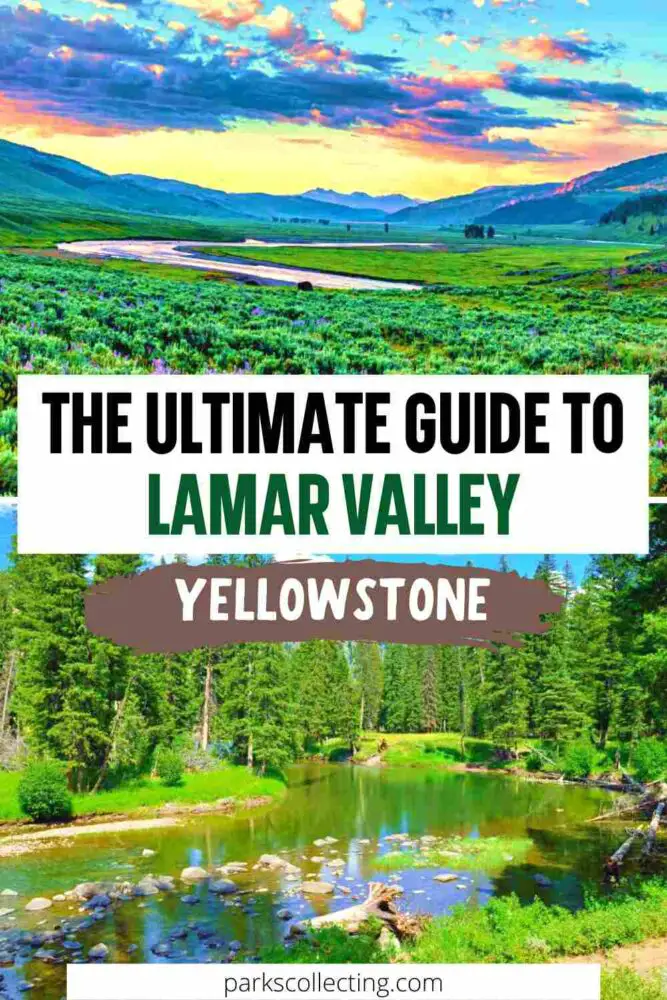
💡 Are you just starting to think about taking a national parks trip? Get Inspiration
‼️ Are you looking for helpful tips for visiting US national parks? Read articles that share useful tips on a range of national-park related issues
💻 Are you starting to plan a trip to Yellowstone National Park? Read my Guide to Yellowstone National Park
📋 Do you want a ready-made super detailed plan for your trip to Yellowstone? Get a detailed 1 – 4-day Yellowstone National Park Itinerary
🛏️ Are you looking for a place to stay in or near Yellowstone National Park? Find a vacation rental near Yellowstone National Park or ⛺ Find a campground inside Yellowstone National Park
💲 Are you ready to book your trip? Use these Planning and Booking Resources
📖 Do you want to read a book about Yellowstone National Park? Check out my Recommended Reading List for Yellowstone National Park
About the Author
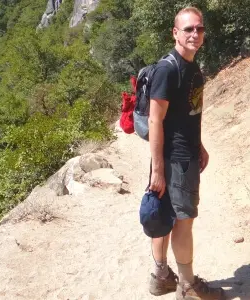
James Ian is a national park, camping and hiking expert.
He has dedicated his life to travel, visiting more than 80 countries, all 7 continents and most of the national parks in the United States. With over 35 years experience in the travel industry, James has worked on cruise ships, at resorts and hotels, and as a travel planner who’s helped hundreds of people plan successful trips to US national parks.
Based on his experience visiting our national parks multiple times, in-depth research and expertise as a travel planner, James has published detailed itineraries for many of the major national parks in the US. These itineraries, as well as in-depth park guides, and other resources will help you have your own incredible trip to US national parks without stress and hassle.
As a national park expert, James has contributed to many publications, including USA Today, Newsweek, Time Business News, Savoteur, Best Trip, and Wired.
I’m a member of the Amazon Services LLC Associates Program. As an Amazon Associate I earn from qualifying purchases.




